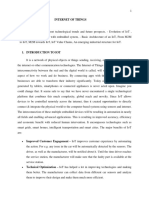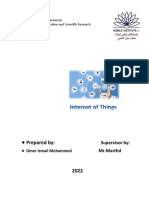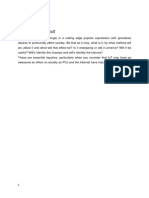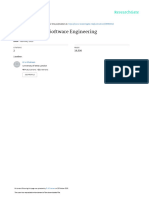0 ratings0% found this document useful (0 votes)
66 viewsLiving in The Technological World
Living in The Technological World
Uploaded by
Kris Anthony SyThis document provides examples and explanations of five different types of internet of things (IoT) technologies: (1) smart home technology using a smart TV, (2) wearable technology like smartwatches, (3) smart cities using smart parking meters, (4) connected cars that can link to other services, and (5) motion detection devices like those that monitor structures. It also lists five benefits of IoT for organizations in enhancing customer service, work productivity, decision-making, business operations, and opportunities. Finally, it discusses five emerging trends in information technology: artificial intelligence, virtual reality, augmented reality, drones, and 5G networks.
Copyright:
© All Rights Reserved
Available Formats
Download as DOCX, PDF, TXT or read online from Scribd
Living in The Technological World
Living in The Technological World
Uploaded by
Kris Anthony Sy0 ratings0% found this document useful (0 votes)
66 views5 pagesThis document provides examples and explanations of five different types of internet of things (IoT) technologies: (1) smart home technology using a smart TV, (2) wearable technology like smartwatches, (3) smart cities using smart parking meters, (4) connected cars that can link to other services, and (5) motion detection devices like those that monitor structures. It also lists five benefits of IoT for organizations in enhancing customer service, work productivity, decision-making, business operations, and opportunities. Finally, it discusses five emerging trends in information technology: artificial intelligence, virtual reality, augmented reality, drones, and 5G networks.
Original Title
Living in the technological world
Copyright
© © All Rights Reserved
Available Formats
DOCX, PDF, TXT or read online from Scribd
Share this document
Did you find this document useful?
Is this content inappropriate?
This document provides examples and explanations of five different types of internet of things (IoT) technologies: (1) smart home technology using a smart TV, (2) wearable technology like smartwatches, (3) smart cities using smart parking meters, (4) connected cars that can link to other services, and (5) motion detection devices like those that monitor structures. It also lists five benefits of IoT for organizations in enhancing customer service, work productivity, decision-making, business operations, and opportunities. Finally, it discusses five emerging trends in information technology: artificial intelligence, virtual reality, augmented reality, drones, and 5G networks.
Copyright:
© All Rights Reserved
Available Formats
Download as DOCX, PDF, TXT or read online from Scribd
Download as docx, pdf, or txt
0 ratings0% found this document useful (0 votes)
66 views5 pagesLiving in The Technological World
Living in The Technological World
Uploaded by
Kris Anthony SyThis document provides examples and explanations of five different types of internet of things (IoT) technologies: (1) smart home technology using a smart TV, (2) wearable technology like smartwatches, (3) smart cities using smart parking meters, (4) connected cars that can link to other services, and (5) motion detection devices like those that monitor structures. It also lists five benefits of IoT for organizations in enhancing customer service, work productivity, decision-making, business operations, and opportunities. Finally, it discusses five emerging trends in information technology: artificial intelligence, virtual reality, augmented reality, drones, and 5G networks.
Copyright:
© All Rights Reserved
Available Formats
Download as DOCX, PDF, TXT or read online from Scribd
Download as docx, pdf, or txt
You are on page 1of 5
1. List and explain thru an example for each of the 5 internet of things.
1. Smart home technology - Our Flatscreen T.V has a Smart Hub
application that is connected to our Wi-Fi which helps us to
access browser, youtube, netflix and screen mirroring. It is also
often referred to as home automation or domotics, it provides
homeowners' security, comfort, convenience and energy
efficiency by allowing them to control smart devices, often by a
smart home app on their smartphone or other networked
device.
2. Wearable technology - also known as "wearables", is a
category of electronic devices that can be worn as accessories,
embedded in clothing, implanted in the user's body, or even
tattooed on the skin and this devices are hands-free gadgets
with practical uses, powered by microprocessors and enhanced
with the ability to send and receive data via the Internet. One
example of this device is a smartwatch that is available in
Cherry Mobile and other brands, it includes monitoring your
heart rate, tracking your activity, and providing reminders
throughout the day.
3. Smart City - is a municipality that uses information and
communication technologies (ICT) to increase operational
efficiency, share information with the public and improve both
the quality of government services and citizen welfare. A classic
example is the smart parking meter that uses an application to
help drivers find available parking spaces without prolonged
circling of crowded city blocks.
4. Connected Car - Experts define a connected car as a car that
can be linked to other services, devices via a network, along
with laptops and mobile phones, this also includes other
connected car technology, your own home, office, or parts of
infrastructure such as traffic signals or emergency centres.
Examples of connected car devices are the new Audi
commercial featuring Tom Holland which shows how the car
automatically parks on its own, also it is used by Grab drivers
which help them sense heavy traffic that would potentially
enable road users to reach their destination with less stress.
5. Motion Detection - are devices that use sensors to detect
motion or vibration in large-scale structures such as buildings,
bridges, and dams can identify the small disturbances and
patterns that could lead to catastrophic failures. Networks of
detectors are also used in areas susceptible to landslides,
avalanches, and earthquakes. Example of a Motion Detection
device is the LG G8 ThinQ Air Motion which allows you to
control your device without touching it via motions and
gestures.
2. Apply 5 benefits of IoT in organizations justify in 1 to 2 sentences.
1. Enhance Customer Service - With the help of IoT, organizations
are able to reduce their wasted time and also the number of
resources required to manage their assets. For instance, IoT
such as artificially intelligent robots that can automatically sort
and place items at appropriate locations without human
intervention can lead to a higher level of customer satisfaction.
2. Enhance Work Productivity - Just as how robotics eliminated
repetitive physical tasks, the IoT consists of "cognitive
outsourcing" which will enable computers to be responsible for
menial or repetitive mental tasks, enabling personnel to spend
more time on finding operational insights rather than collecting,
transforming, and processing the data. It costs more money
and time in handling cost optimization manually because you
have to pay an expert that is knowledgeable in linear equations
and calculus.
3. Make Better Business Decision-Making - IoT contains digital
literacy and ICT skills which majority of organizations seek, and
also, IoT enhances situational awareness and empowers new
contextual insights, resulting in faster and better-informed
decision-making. Also, IoT-enabled rapid costing upends this
system: receive time-based price signals, update your
analyses, analyze trade-offs, and choose the optimal response.
4. Smooth Business Operations - IoT can connect through various
devices to the internet which allows enterprises to have real-
time operational insights and it helps them analyze the situation
or problems that the business encounters. IoT devices
empower individuals as well as organizations to be more
efficient and productive.
5. Provide Ample Business Opportunities - IoT opens the door for
new business opportunities and by introducing a new way to
interact with customers, business flow, productions and much
more. IoT-driven innovations create an astounding atmosphere
which helps businesses to establish a better relationship with
the customer and by offering practical solutions.
3. List 5 emerging Trends in Information Technology and explain in 1
to 2 sentences.
1. Artificial Intelligence - there are many games in recent years
that uses A.I such as DOTA( Defense of the Ancients), Chess,
games in playstation, arcade, gameboy, computer, mobile and
many more but it continues to be a trend because it slowly
developing to becoming a unbeatable opponent that can
surpass the human brain, back then, many people can outsmart
the performance of an A.I, however, as time goes by, it became
flawless and can obtain common sense similar to humans.
Artificial intelligence harnesses algorithms and machine
learning to predict useful patterns humans normally identify.
Smart machines take human decision-making out of the
equation so intelligent machines can instigate changes and
bring forward solutions to basic problems.
2. Virtual Reality - It creates new experiences that you will never
feel in any other Information technology because instead of
viewing a screen in front of them, users are immersed and able
to interact with 3D worlds, also, it simulates as many senses as
possible, such as vision, hearing, touch, even smell, the
computer is transformed into a gatekeeper to this artificial
world. Virtual reality refers to a computer-generated simulation
in which a person can interact within an artificial three-
dimensional environment using electronic devices, such as
special goggles with a screen or gloves fitted with sensors and
in this simulated artificial environment, the user is able to have
a realistic-feeling experience.
3. Augmented Reality - When I went on a trip to Ateneo since I
was in elementary school, it was the first time that I
experienced playing augmented reality which is very exciting
and amusing because it is like you are transferred to the 3D-
world you are facing and the character that you use is doing the
same movement that you do. Augmented reality (AR) is an
enhanced version of the real physical world that is achieved
through the use of digital visual elements, sound, or other
sensory stimuli delivered via technology.
4. Drones - A news that shocked people all over the world on
January 3,2020, is all about a U.S. drone strike that killed Iran’s
top general, Qassem Soleimani, at Baghdad International
Airport which causes terror or a possible world war because of
the armed drone attack. A drone, in technological terms, is an
unmanned aircraft. Drones are more formally known as
unmanned aerial vehicles (UAVs) or unmanned aircraft systems
(UASes). Essentially, a drone is a flying robot that can be
remotely controlled or fly autonomously through software-
controlled flight plans in their embedded systems, working in
conjunction with onboard sensors and GPS.
5. 5G - It is an ongoing trend that you will see in many brands
such as globe, apple and many more, 5G is the 5th generation
mobile network that enables a new kind of network that is
designed to connect virtually everyone and everything together
including machines, objects, and devices. 5G wireless
technology is meant to deliver higher multi-Gbps peak data
speeds, ultra low latency, more reliability, massive network
capacity, increased availability, and a more uniform user
experience to more users.
You might also like
- Spreadsheet Modeling and Decision Analysis A Practical Introduction To Business Analytics 8th Edition Ragsdale Solutions ManualDocument44 pagesSpreadsheet Modeling and Decision Analysis A Practical Introduction To Business Analytics 8th Edition Ragsdale Solutions ManualTrevor feignarddNo ratings yet
- OnlineGold BeatOnlineCasinosDocument161 pagesOnlineGold BeatOnlineCasinosDiana DianaNo ratings yet
- IT Module 6Document4 pagesIT Module 6James SwintonNo ratings yet
- Emerging Trends in Information Technology: I) Big DataDocument6 pagesEmerging Trends in Information Technology: I) Big DataDipak BholeNo ratings yet
- EditingDocument60 pagesEditingBollam Pragnya 518No ratings yet
- Moizuddin Shaikh IOT AsgnmtDocument12 pagesMoizuddin Shaikh IOT Asgnmtcontact.moizuddinNo ratings yet
- Unit IV Emerging TrendsDocument7 pagesUnit IV Emerging Trendsrehanansari687.786No ratings yet
- It Culture and The SocietyDocument6 pagesIt Culture and The SocietyLilian May MalfartaNo ratings yet
- Current Trends and Emerging TechnologiesDocument13 pagesCurrent Trends and Emerging Technologies2300546No ratings yet
- Module 9 - Trends in ITDocument11 pagesModule 9 - Trends in ITANHIBEY, JEZREEL ACE S.No ratings yet
- Zero LabDocument4 pagesZero Labtaehyung kimNo ratings yet
- A Comprehensive Study On IotDocument21 pagesA Comprehensive Study On IotAman Saxena100% (1)
- Jawo DocsDocument7 pagesJawo DocsChe RryNo ratings yet
- Lecture 1 Introduction To IoTDocument68 pagesLecture 1 Introduction To IoTMadhan Sai SNo ratings yet
- Internet of Things: ExampleDocument9 pagesInternet of Things: ExampleAiman Aslam KhanNo ratings yet
- Internet LastDocument12 pagesInternet Lastapi-420810665No ratings yet
- Artificial Intelligence and Smart Machines - An Intelligence Demonstrated by Computers or MachinesDocument2 pagesArtificial Intelligence and Smart Machines - An Intelligence Demonstrated by Computers or MachinesHirouiNo ratings yet
- The Internet of Things (Iot)Document25 pagesThe Internet of Things (Iot)Ankit ThakkarNo ratings yet
- Current Future Trends of Media and InformationDocument2 pagesCurrent Future Trends of Media and InformationRichbel Orjohn OrhinNo ratings yet
- Internet of Things Assignment - 4: Question 1-Conceptualize Iot Framework For Home Automation. AnsDocument11 pagesInternet of Things Assignment - 4: Question 1-Conceptualize Iot Framework For Home Automation. AnsHingulaNo ratings yet
- Iot AssignmentDocument3 pagesIot Assignmentsana mairajNo ratings yet
- 9 Current Technology TrendsDocument32 pages9 Current Technology Trends5c6z4c7qn9No ratings yet
- Internet of Things: Sumbitted By: Azeem ArshadDocument9 pagesInternet of Things: Sumbitted By: Azeem ArshadAzeem ArshadNo ratings yet
- IOT Notes 1Document264 pagesIOT Notes 1Ramesh BabuNo ratings yet
- Lecture 6Document23 pagesLecture 6serephinelunNo ratings yet
- Internet of Things.Document12 pagesInternet of Things.ankee16taNo ratings yet
- Iot Unit 1Document49 pagesIot Unit 1sandeep ReddyNo ratings yet
- Internet of ThingsDocument31 pagesInternet of ThingsBabita NaagarNo ratings yet
- Csc034 ActivityDocument11 pagesCsc034 ActivityfarahNo ratings yet
- Unit 5Document28 pagesUnit 5V MERIN SHOBINo ratings yet
- Internet of ThingsDocument2 pagesInternet of ThingsRachit SrivastavaNo ratings yet
- Design of IOTDocument39 pagesDesign of IOTlaxmimane245No ratings yet
- Internet of ThingsDocument11 pagesInternet of ThingsVimal SharmaNo ratings yet
- Living in IT ERA - 06 IT Culture and The SocietyDocument17 pagesLiving in IT ERA - 06 IT Culture and The SocietyMichael Ereje OrolaNo ratings yet
- 0 - IoT Dev Platform - Project ReportDocument8 pages0 - IoT Dev Platform - Project ReportAniket KhopatkarNo ratings yet
- Iot ReviewerDocument9 pagesIot Reviewerdelapena.kategabrielle.cNo ratings yet
- REPORT ON SMART MODEL Report ItDocument15 pagesREPORT ON SMART MODEL Report ItAkshyath GuptaNo ratings yet
- Bba-2 (Ict) S2Document17 pagesBba-2 (Ict) S2Rimsha TariqNo ratings yet
- Internet of ThingsDocument11 pagesInternet of Thingsالزهور لخدمات الانترنيتNo ratings yet
- Bandwidth Is The Amount of Data Which A Network Can Carry Over Time, UsuallyDocument4 pagesBandwidth Is The Amount of Data Which A Network Can Carry Over Time, UsuallyThraia SmurfNo ratings yet
- Omer Ismail Mohammed PDocument12 pagesOmer Ismail Mohammed POmar EsmailNo ratings yet
- IOT ReportDocument11 pagesIOT ReportpiyushkalsonNo ratings yet
- What Internet of Things Needs To Become A Reality: Kaivan Karimi, Freescale Gary Atkinson, ARM 10/30/2012 10:57 AM EDTDocument11 pagesWhat Internet of Things Needs To Become A Reality: Kaivan Karimi, Freescale Gary Atkinson, ARM 10/30/2012 10:57 AM EDTAndrej GrobisaNo ratings yet
- The Internet of Things ReportDocument29 pagesThe Internet of Things ReportPari RaniNo ratings yet
- What The Internet of Things (Iot) Needs To Become A Reality: White PaperDocument16 pagesWhat The Internet of Things (Iot) Needs To Become A Reality: White PaperNin TeoNo ratings yet
- Updated New Format Internship Report - Smart Car Parking SystemDocument16 pagesUpdated New Format Internship Report - Smart Car Parking SystemHarini GowdaNo ratings yet
- IoT Unit I - OverviewDocument27 pagesIoT Unit I - OverviewGsNo ratings yet
- Latest Technology Trends 1. Artificial Intelligence (AI)Document8 pagesLatest Technology Trends 1. Artificial Intelligence (AI)Eden Mae DeGuzmanNo ratings yet
- SJKT Simpang LimaDocument13 pagesSJKT Simpang LimaMUKUNDHA A/L RAVI MoeNo ratings yet
- Chapter 1Document22 pagesChapter 1Harshitha Khandelwal100% (1)
- 13 - Chapter 5Document32 pages13 - Chapter 5Mridul RainaNo ratings yet
- Presentation Prepared by Inocentes, Peter Charles Rahim, Haguiar Pescadero, AltheaDocument18 pagesPresentation Prepared by Inocentes, Peter Charles Rahim, Haguiar Pescadero, AltheaAbe SakalNo ratings yet
- Pamantasan NG Cabuyao: College of Computing and EngineeringDocument9 pagesPamantasan NG Cabuyao: College of Computing and EngineeringAnge HaeNo ratings yet
- Managing Information and TechnologyDocument10 pagesManaging Information and TechnologyDionechordNo ratings yet
- Picking Up Pebbles On IoT RoadmapDocument7 pagesPicking Up Pebbles On IoT RoadmapKavitha NarayanaswamyNo ratings yet
- Unit-1 Notes Intro To IotDocument32 pagesUnit-1 Notes Intro To IotPRADEEP KOPPARTHINo ratings yet
- 4351703-IOT 5 SEM: Jesika Kothari Jesika Kothari Ic Department Avpti RajkotDocument22 pages4351703-IOT 5 SEM: Jesika Kothari Jesika Kothari Ic Department Avpti Rajkotchavdamayur440No ratings yet
- Unit v. It Culture and The SocietyDocument9 pagesUnit v. It Culture and The SocietydonitamaediosanoNo ratings yet
- Internet of Things General Observations: Iot DRDocument7 pagesInternet of Things General Observations: Iot DRakashtubeyou554No ratings yet
- 5Document2 pages5ellaine villafaniaNo ratings yet
- Internet of Things (Iot) : Security Challenges, Business Opportunities & Reference Architecture For E-CommerceDocument5 pagesInternet of Things (Iot) : Security Challenges, Business Opportunities & Reference Architecture For E-CommerceKMBANo ratings yet
- StatsDocument5 pagesStatsKris Anthony SyNo ratings yet
- What Is The Most Important Driving Force For Product Design or Redesign?why?Document7 pagesWhat Is The Most Important Driving Force For Product Design or Redesign?why?Kris Anthony SyNo ratings yet
- Autonomous Region in Muslim Mindanao: Historical BackgroundDocument5 pagesAutonomous Region in Muslim Mindanao: Historical BackgroundKris Anthony SyNo ratings yet
- Lesson 1: Operations and Productivity Activity/AssessmentDocument2 pagesLesson 1: Operations and Productivity Activity/AssessmentKris Anthony SyNo ratings yet
- Communication ModesDocument9 pagesCommunication ModesKris Anthony SyNo ratings yet
- Pantwaid Pamilya Pilipino Program ResearchDocument6 pagesPantwaid Pamilya Pilipino Program ResearchKris Anthony SyNo ratings yet
- Privacy-Preserving Machine Learning On Encrypted Data Using Homomorphic EncryptionDocument6 pagesPrivacy-Preserving Machine Learning On Encrypted Data Using Homomorphic EncryptionsandeshkokadNo ratings yet
- Experion Process Knowledge System (PKS) : Experion Server Specifications and Technical DataDocument38 pagesExperion Process Knowledge System (PKS) : Experion Server Specifications and Technical DataGoranNo ratings yet
- Rab Klinik BimaDocument8 pagesRab Klinik Bimaagus dwi pitonoNo ratings yet
- International Journal of Rock Mechanics & Mining Sciences: A. Malinowska, R. HejmanowskiDocument8 pagesInternational Journal of Rock Mechanics & Mining Sciences: A. Malinowska, R. HejmanowskijalexvegaNo ratings yet
- Performance Criteria For Safeguarding: ANSI B11.19-2003Document65 pagesPerformance Criteria For Safeguarding: ANSI B11.19-2003luckiflyNo ratings yet
- Course Outline MITDocument3 pagesCourse Outline MITlandry NowaruhangaNo ratings yet
- 2015-Learning Hierarchical Representation Model For Next Basket RecommendationDocument11 pages2015-Learning Hierarchical Representation Model For Next Basket RecommendationIftekhar AhmadNo ratings yet
- Math Lecture5Document17 pagesMath Lecture5yasin pathanNo ratings yet
- Pi 0Document17 pagesPi 0nl1no00001No ratings yet
- Designing For Fire Safety NotesDocument186 pagesDesigning For Fire Safety NotesTanNo ratings yet
- Leica Lens Book: Leica M System, Leica R SystemDocument9 pagesLeica Lens Book: Leica M System, Leica R SystemseifadiazNo ratings yet
- Cpar m10 Contemporary Art PracticesDocument17 pagesCpar m10 Contemporary Art Practicesjoshua bravoNo ratings yet
- Nissei ASB 150 Series BrochureDocument8 pagesNissei ASB 150 Series BrochureDawn UnderNo ratings yet
- HDPE Pipe System Design PDFDocument16 pagesHDPE Pipe System Design PDFBill GuNo ratings yet
- Spam 150 C Motor Protection Relay: User S Manual and Technical DescriptionDocument13 pagesSpam 150 C Motor Protection Relay: User S Manual and Technical DescriptionrpshvjuNo ratings yet
- MAXDNA Upgradation ChecklistDocument3 pagesMAXDNA Upgradation Checklistkundan RathodNo ratings yet
- SEBookDocument215 pagesSEBooksuman.bscs22seecsNo ratings yet
- What Is A Noun ClusterDocument3 pagesWhat Is A Noun ClusterGreny p. officialNo ratings yet
- Sunway Lagoon - MimiDocument5 pagesSunway Lagoon - MimiMuhammad HafizNo ratings yet
- Australian Standard: Automatic Fire Sprinkler Systems Part 2: Wall Wetting Sprinklers (Drenchers)Document8 pagesAustralian Standard: Automatic Fire Sprinkler Systems Part 2: Wall Wetting Sprinklers (Drenchers)gvassalloNo ratings yet
- Line BalacingDocument24 pagesLine BalacingVijayakrishnan K. MNo ratings yet
- Actuador BaumannDocument16 pagesActuador Baumannnora alicia rangelNo ratings yet
- Ec8395 Ce Notes 1Document127 pagesEc8395 Ce Notes 1makNo ratings yet
- Development of Android Based Application For Philippine Coordinate Transformation (Phgeocalc)Document86 pagesDevelopment of Android Based Application For Philippine Coordinate Transformation (Phgeocalc)Shekaina love AnibanNo ratings yet
- Park5 - Amore Animal Clinic - MMI 12 Feb 2021Document3 pagesPark5 - Amore Animal Clinic - MMI 12 Feb 2021bagas satriyaNo ratings yet
- HEO Hydraulic Excavator List of Tools Equipment and ConsumablesDocument3 pagesHEO Hydraulic Excavator List of Tools Equipment and ConsumablesRoi Jason Carillo DetorresNo ratings yet
- Introductio 1Document12 pagesIntroductio 1Khamkar GaneshNo ratings yet
- Differential Equations - Vol1 - Worksheet 3 Separation of VariablesDocument44 pagesDifferential Equations - Vol1 - Worksheet 3 Separation of VariablesEunice MaeNo ratings yet































































































